Table of Contents
Why to Use a Crate for Akita?
Akita is bred to be a great family dog, family guard and to live with humans. Nevertheless Akita needs his own space at home. Akita (or big Japanese dog), like a real samurai, prefers to keep an eye on all family members and to control what is happening around, but he is not intrusive or bothersome at all. Akita will never tumble underfoot, and you should give the dog some time to be on his own. A comfy dog bed and a crate make an ideal combination for that purpose. Additionally, crate training will save your belongings and teach Akita discipline. In this article, we’re going to review the best size crate for Akita, how to measure and how to choose a perfect crate. Why to use a crate and what are the types.
5 Reasons to Buy a Crate for Akita
- To prevent destructive behaviour
- A crate is a safe home for Akita where he can stay on his own far from the crowd if he needs
- Being very loyal, Akita may follow his master from room to room, or wait near each door. Crate training and knowing his place, makes Akita’s and whole family life more comfortable
- Travelling will become more safe and comfortable if Akita is accustomed to stay in a crate for a couple of hours
- A place to stay when you have visitors
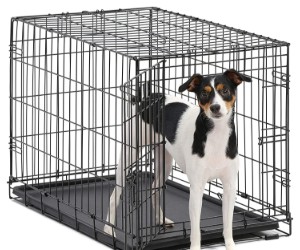
What Size Crate for an Akita?
The size of the dog crate must be a balance between just enough space and too much space. Remember that your Akita must be able to stand, turn around, and lie down comfortably. If your dog can’t do that, they will be stressed and uneasy.
Akita can grow to a height up to 28 inches and weigh up to 130 pounds, as AKC states. Females are usually smaller. The normal crate size required for an adult Akita is between 48L x 30W x 33H inches. But Akitas differ in size very much, so we recommend to measure a pup and then to follow crate producer sizing chart.
If you want to be sure of what crate to buy, you can measure the body length of your pup by yourself: from nose to tail base. Dog length is actually the most important measurement. For a grown-up Akita it is between 36 and 43 inches normally.
If you don’t want to change the crate until your pup grows, ask for his parents’ length and buy a crate with divider.
As, if you get a very spacious crate, for growing up, your puppy can sleep in one corner and do his thing in the other. Dogs don’t soil where they sleep and eat that’s why it’s essential to choose a crate that is just the size of your dog.
Types of Crate for Akita Puppy and Grown-Up
Best Metal Wire Crate for Home  | MidWest Homes for Pets Dog Crate
| Check Price |
|---|---|---|
Best Plactic Kennel  | Petmate Aspen Heavy-Duty Pet Kennel
| Check Price |
Best Heavy Duty Dog Kennel 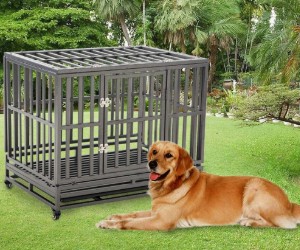 | LuckUp Heavy Duty Dog Crate Strong Metal Kennel and Crate for Large Dogs
| Check Price |
Pet stores offer a wide range of crates for dogs: small plastic kennels, spacious metal crates, soft fabric carriers etc. There is no one-size-fits-all solution. The choice has to be made based on the reasons that prompted the owner to purchase it. But with this type of breed, a metal crate and plastic kennels are the best choices.
You may also like
Soft Sided Carrier
Plastic dog kennels are popular for its compact and secured walls. Easy to clean and wash. However, it’s not open to circulate air. The best time to use a plastic kennel is when traveling by car, not at home.
Plastic Kennel
Plastic dog kennels are popular for its compact and secured walls. Easy to clean and wash. However, it’s not open to circulate air. The best time to use a plastic kennel is when traveling by car, not at home.
Metal Crate and Heavy Duty Kennel
Metal Crates are durable and resistant to chewing. It is something that will protect your home from Akita’s chewing habits and the best choice for a cozy home or yard.
Where Should I Place a Crate?
At first, you can put the crate near your bed to help your dog easily adjust to the environment and not feel alone. When he’s fully trained, you can put the crate to the proper place. Proper crate training will help your dog understand that the crate is his own space and safe haven. He will be used to staying inside during the wee hours or when the whole family is together.
Remember, do not put the crate next to the hot or cold area of your house. Heat and cold are not good for your dog’s health. In terms of hygiene, the children’s room or kitchen is not a good place for your dog to stay.
What to Put into a Crate?
- Put a comfortable dog bed inside.
- Keep your dog hydrated in a crate and provide him with enough water. The special water dispenser bowl is the best.
- Put his favorite toys inside. They help to cope with anxiety and boredom. Snuggle toys with heart bit are a wonderful solution for puppies at night.
How to Crate Train an Akita?
5 Things You Should NEVER Do When Crate Training an Akita
- Crate is not a resource for punishment
- Do not EVER hurt a dog inside the crate
- Do not leave your dog in a crate with a collar, harness, and leash on
- Do not force your puppy to get into the crate when he’s not ready
- Don’t use the crate as an alternative to training and walking
Basic Rules to Crate Train an Akita Puppy
Your dog’s first introduction to his crate should always be as positive as possible.
- Provide your puppy all the comfort inside the crate such as bed, blanket, toys, and chews. Remove all the comfortable places in the house where your pup would try to sleep. Don’t let him lay down on the couch or bed.
- Reward your puppy when he enters the crate to lie down. Give him a treat or unique chew and affectionate praises. Command your pup “good crate”.
- When your Akita pup starts to lie down on his own for short periods of time, begin closing the door for 1-2 minutes and reward for a positive, calm behavior.
- Gradually increase the time you keep the door closed. Keep an eye on your puppy by checking frequently or using a nanny cam and release her if there is any discomfort
- Begin asking your dog to go to her crate at bedtime or when you will leave for a few hours. Reward her for entering the crate.
- It is best to get accustomed to a long stay in the crate at night when the furbaby is calm and wants to sleep.
Remember!
Being locked up won’t make your pet obedient and socialized. Having a cozy dog refuge limits your apartment’s possibility of being smashed, but does not negate the need to raise, train, and socialize your dog. By restricting Akitas’s movements during your absence of a host, try to make up for his lack of physical activity during walks and communicate with him as much as possible during his time at home
7 Tips for Initial Crate Training an Akita Puppy
- The first thing to do is to walk your dog. Then take off his collar to avoid awful accidents in his crate. Use toys or treats to attract your dog, praise him with loving words, and give him a treat when he enters inside. Remember, the crate should only cause positive emotions.
- The crate training should be uplifting to the mood. You can turn it into a mini-game. Leave the door open first then repeat it 10-20 times a day.
- Do not leave your dog in the crate for an extended period. When your dog starts to enter his home with confidence, try leaving him there for short periods of time. If your dog is quiet and calm while in the crate, praise him. If he barks or whines, ignore him until he calms down and then praise him.
- If your dog is being noisy, try covering the crate with something like a cloth. It’s normal that younger dogs are clingy, but whining and barking are not signs that he is not into the crate. He just wants to be with you.
- Gradually increase the crate training when you see that he’s starting to get comfortable. Do not forget to praise him every time he’s behaved. And don’t forget to walk your dog once you let him out.
- If your puppy falls asleep during class, don’t wake him up. When he wakes up, let him out and don’t praise him, play, caress him, or pay any attention to him for a few minutes. Let him think he’s loved much more when he’s in a crate. And don’t let the puppy out of the crate until he’s been quiet for 30 seconds.
- Once you close the crate door, try to spend some time close to your dog and talk to him about something to distract the uneasiness. If your puppy starts whining, distract him, smell his own fingers until he stops, and open the crate. Stay close to him. This training takes 5-10 minutes.
3 Tips to Keep your Akita Puppy in a Crate over Night
- Once your pup learned the lessons above, it will now be easier to keep him in the crate at night. It’s crucial to tire him out, for example, by playing or luring him to his crate. If he starts whining, put your hand, or slip your fingers inside and gently talk to him. Don’t get mad or yell at him.
- As a rule, a tired two-month-old puppy can sleep for four hours. If he wakes up in the middle of the night demanding to be released to go potty, let him do it. Take or take your puppy to a place where he is allowed to do that. If you want to take him outside, dress first, and then open the crate. After he’s done, put him in the crate without playing, turn off the light and go back to bed. If he starts whining again, give him your palm, and talk to him gently.
- It will take two or three nights to make him get used to this ultimately. In a week or two, try to leave the crate somewhere else in your apartment.
Final Tips to Leave an Akita Puppy in a Crate when You are out of Home
- Do not use force. Don’t forget to take off the collar once you invite him inside his crate.
- Close the crate and don’t talk about anything, just go and that’s it. But remember, do not leave him for more than 2 hours. If you are out longer than that, make sure that you have someone to feed your puppy and walk him around in your absence.
- Once you’ve done and mastered the training exercises above, it will be easier to make your dog stay in the crate when you leave home. Once you decide to leave him for a while, make sure that he’s tired and walked.
- If you’re consistent in training your dog, and you are firm in your demands, start to leave your puppy in the crate when you leave home or go to bed. You’ll eventually find your dog climb on his own. You will notice this happens when he’s sleepy, tired, or simply wants to be alone. When you’re at home, just open the crate door.
It’s believed that the time your puppy can spend in the crate without going out can be calculated by the formula:
Age in months + one month = the number of hours. For example, a 2-month-old puppy can stay in a crate for 3 hours.
How to Crate Train an Adult Akita?
If you’re going to crate train an adult dog, use the same technique for puppies. Make sure your dog walks safely into the crate after a toy or food without closing the doors. ALWAYS feed him inside the crate.
After two or three days of training, encourage your dog to enter the crate without giving or showing anything. Praises, food, and toys should only be given when he comes the crate.
Give him a couple more days, then put there by command when feeding or giving him toys. Sit next to the crate, don’t close the door. Gradually increase the training time. Then try to close the crate for one to two minutes. If he barks or whines, ignore him. Praise him if he’s quite. Make your dog realize that barking is not a way to open the door.
It’s also important to let your dog know that you love him when he’s in the crate, so when he leaves the crate – don’t mind him for a few minutes.
Continue doing this as you increase his stay inside. Avoid, do not use harsh words and violence. Be patient, as it takes a couple of months for an adult dog to stay in his crate. After that, it will be easier for you to crate train your dog at home or when traveling.
Summary
Train Akita properly and let him know that the crate is his haven and personal space, where he can stay, rest and observe his whole family. Crate training is the best option to prevent your dog from being destructive. Just keep in mind that it takes a lot of patience to train your Akita. Everything will become comfortable and easier for both of you once your dog is fully trained.
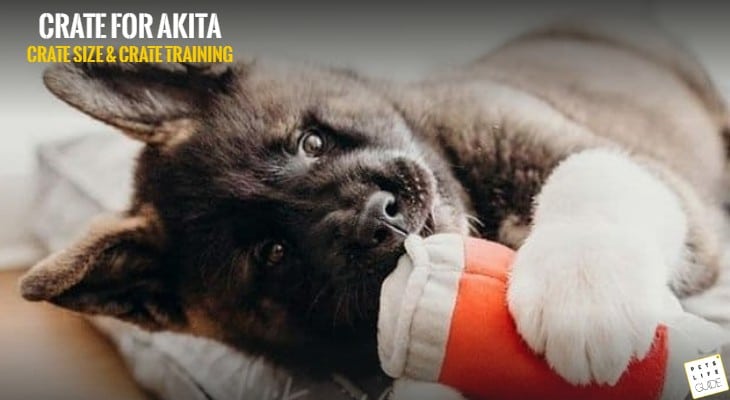
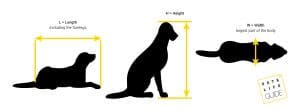
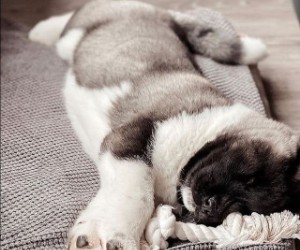
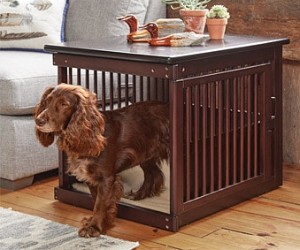


Leave a Reply